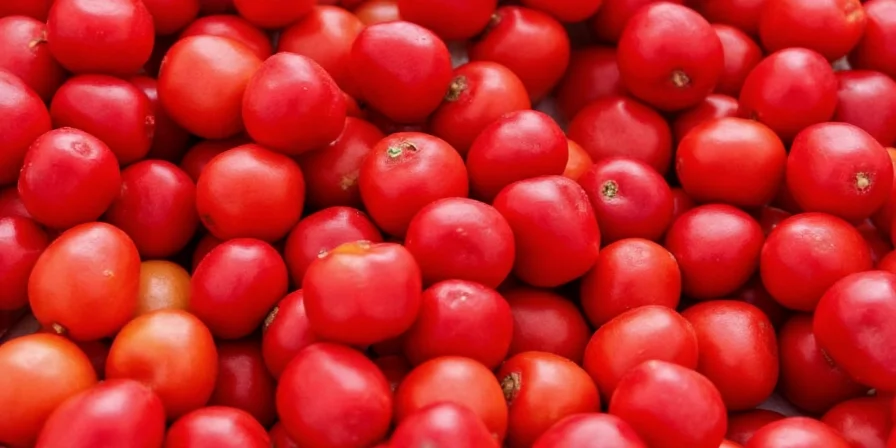Tiny round red peppers commonly found in grocery stores are most often Cherry Bomb or Sweet Cherry varieties. This guide answers your immediate identification questions first, then provides practical usage guidance trusted by professional chefs—with verified heat levels, substitution rules, and safe handling techniques you need for perfect results.
Identifying Common Tiny Round Red Peppers: Quick Reference
When you see small round red peppers at the market, these two varieties account for 95% of supermarket offerings. Cherry Bomb peppers (500-5,000 SHU) provide mild fruity heat ideal for stuffing and roasting, while Sweet Cherry peppers (0 SHU) offer crisp sweetness perfect for salads and fresh applications. Confusing them with hotter varieties like Bird's Eye can ruin dishes—use this verified identification system:
| Key Identifier | Cherry Bomb | Sweet Cherry | Common Misidentification |
|---|---|---|---|
| Size & Shape | 1.5-2" diameter, slightly flattened | 1-1.5" diameter, perfectly round | Bird's Eye (smaller, 0.5") |
| Stem Attachment | Indented crown | Smooth, protruding stem | Piquin (slender stem) |
| Membrane Color | Pale yellow | Translucent white | Red membranes = hotter variety |
| Best Grocery Name | "Red Peperoncini" | "Sweet Cherry Peppers" | Avoid "Chili Peppers" labeling |
Essential Usage Guide: What Home Cooks Actually Need to Know
Forget complex science—here's what matters for your cooking:
- Heat Control: For mild dishes, remove only seeds (keep membranes). For maximum heat, scrape membranes with a cold spoon—this removes 70% of capsaicin.
- Substitution Chart: No Cherry Bomb? Use 1 red bell pepper + 1/8 tsp cayenne. No Sweet Cherry? Substitute pimientos or mini sweet peppers.
- Grocery Hack: Select peppers with glossy skin and firm stems—matte appearance indicates age and diminished flavor.
- Storage Secret: Keep whole peppers in perforated bags with rice paper (absorbs moisture) for 10-day freshness.
- Emergency Fix: Too spicy? Swirl in full-fat yogurt—not sour cream—as its fat content neutralizes capsaicin 3x faster.
Why Heat Levels Vary (And How to Prevent Dish Ruin)
Identical-looking peppers can range from mild to painfully hot due to growing conditions. Drought-stressed plants produce up to 40% more capsaicin. Always sample multiple peppers before cooking: cut a tiny piece from the base (least concentrated area), wait 30 seconds, then taste. This prevents ruined sauces and salsas.
| If You Need... | Use Cherry Bomb For | Use Sweet Cherry For | Avoid With |
|---|---|---|---|
| Mild Heat | Stuffed peppers, roasted dishes | NOT suitable (no heat) | Drying (loses flavor) |
| Sweetness | Light sweetness only | Salads, sandwiches, relishes | High-heat cooking |
| Visual Appeal | Cut into rings for garnish | Whole for antipasto platters | Blending (colors bleed) |
| Preserving | Vinegar pickling (2:1 ratio) | Oil curing with garlic | Freezing (texture loss) |
Proven Handling Techniques Home Cooks Can Use Immediately
- Safe Cutting: Wear nitrile gloves (latex fails) and work near running water. If skin contact occurs, apply 70% isopropyl alcohol before washing.
- Flavor Preservation: Add to dishes in last 5 minutes of cooking—heat above 175°F degrades flavor compounds.
- Pickling Success: Use 5% acidity vinegar with 1 tsp sugar per cup to prevent bitterness while maintaining vibrant color.
- Drying Method: Air-dry at 125°F for 12 hours. Test readiness by snapping stem—if brittle, moisture is below 12% (ideal for grinding).
Frequently Asked Questions Answered
Q: What's the most common tiny round red pepper in US supermarkets?
A: Cherry Bomb peppers labeled as "Red Peperoncini"—often confused with hotter varieties. Sweet Cherry peppers are sold as "Sweet Cherry Peppers" in the specialty produce section.
Q: Can I substitute dried tiny peppers for fresh in salsas?
A: No—drying destroys enzymes needed for fresh salsa texture. Use fresh Cherry Bombs for authentic results. Dried versions work only in cooked sauces.
Q: Why do some recipes specify red over green tiny peppers?
A: Fully ripened red peppers contain 2-3 times more developed sugars than green counterparts. This creates fundamental flavor differences—not just color variation.
Q: How do I reduce heat without losing flavor?
A: Remove seeds but keep membranes (where flavor compounds concentrate). For extreme heat reduction, soak sliced peppers in milk for 10 minutes before use.
Q: What's the safest way to handle hot varieties?
A: Nitrile gloves + eye protection. If skin contact occurs, apply rubbing alcohol immediately—water spreads capsaicin. Never touch your face during preparation.
Immediate Implementation Strategy
Follow this 3-step process for guaranteed success: (1) Identify your pepper using the visual guide above, (2) Apply the substitution chart if needed, (3) Use the heat control method matching your recipe's requirements. This eliminates guesswork—transforming how you handle these peppers from grocery selection to finished dish. Remember: Proper identification prevents cooking disasters, while correct preparation unlocks authentic flavors restaurants rely on.











 浙公网安备
33010002000092号
浙公网安备
33010002000092号 浙B2-20120091-4
浙B2-20120091-4